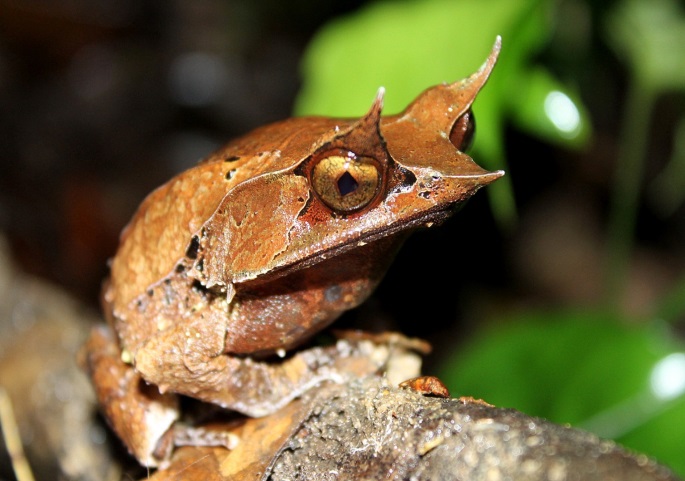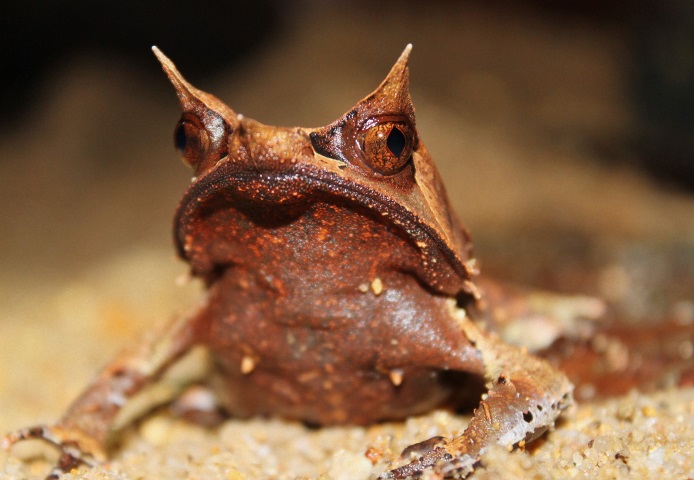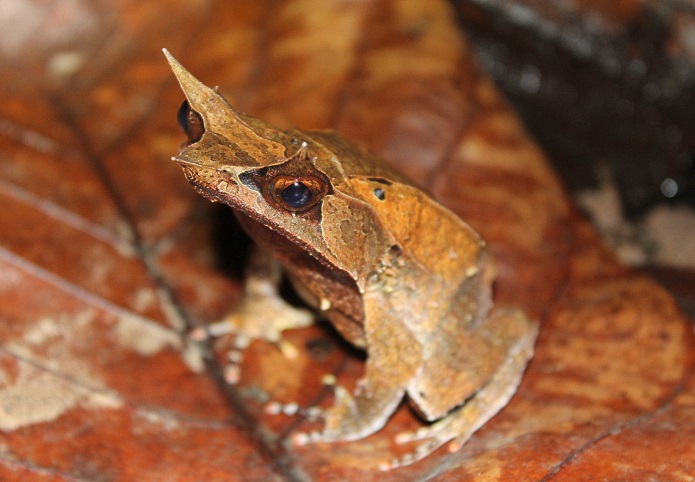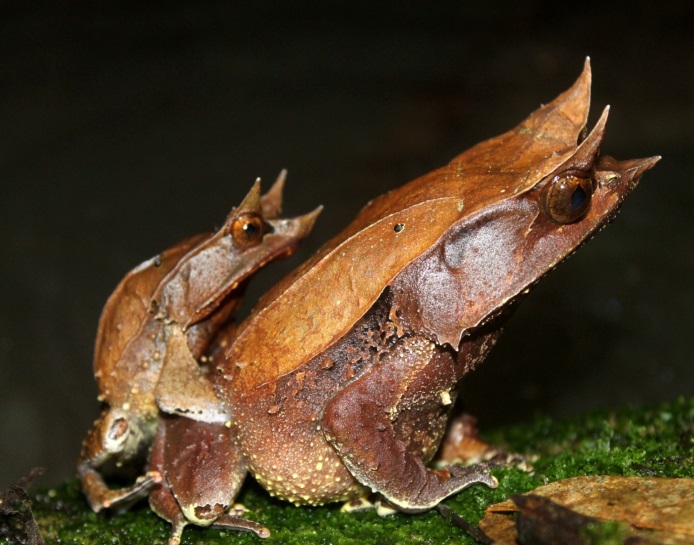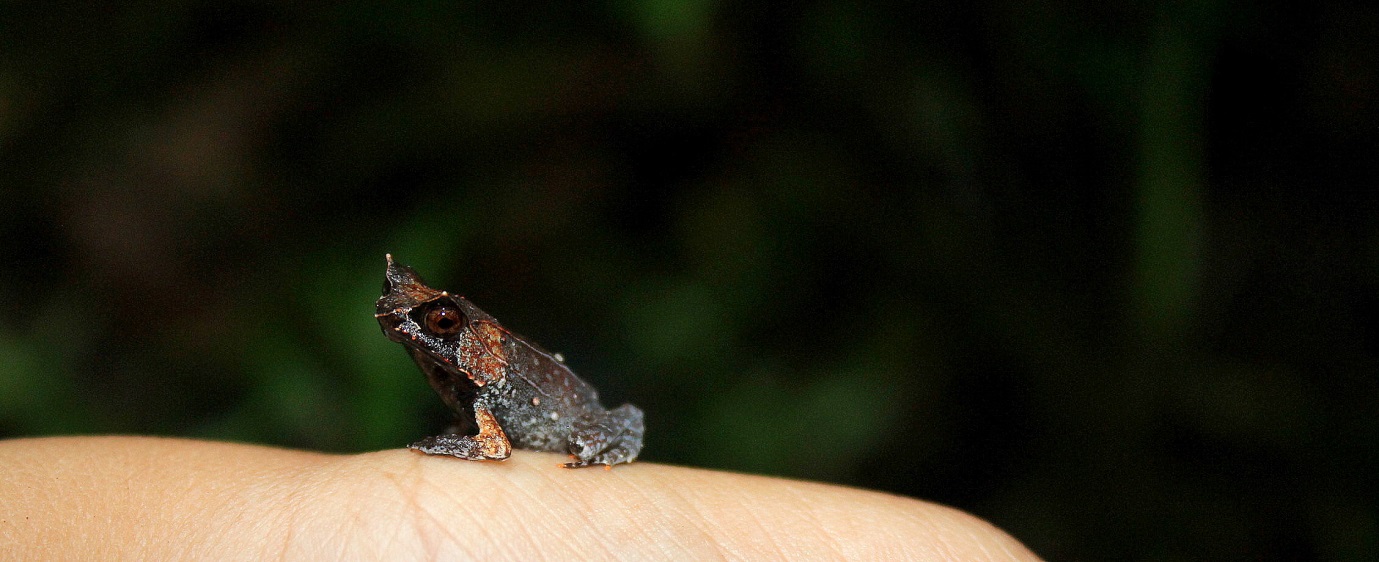
MALAYAN HORNED FROG
Megophrys nasuta (Schlegel,1858)
THE MALAYAN HORNED FROG.-
The Malayan Horned frog was first described by the German ornithologist and herpetologist Hermann Schlegel in 1858. It is often touted as a charismatic species due to its unusual appearance – a pair of horn-like skin projections on its head, and an extended, pointed snout. Betrayed by its loud metallic ‘honk’ for a call (sounding somewhat like a duck with a sore throat ), this species also camouflages remarkably among the leaf litter of the forest floor and in streams.
Do you see what I see? SPOT THE FROG!
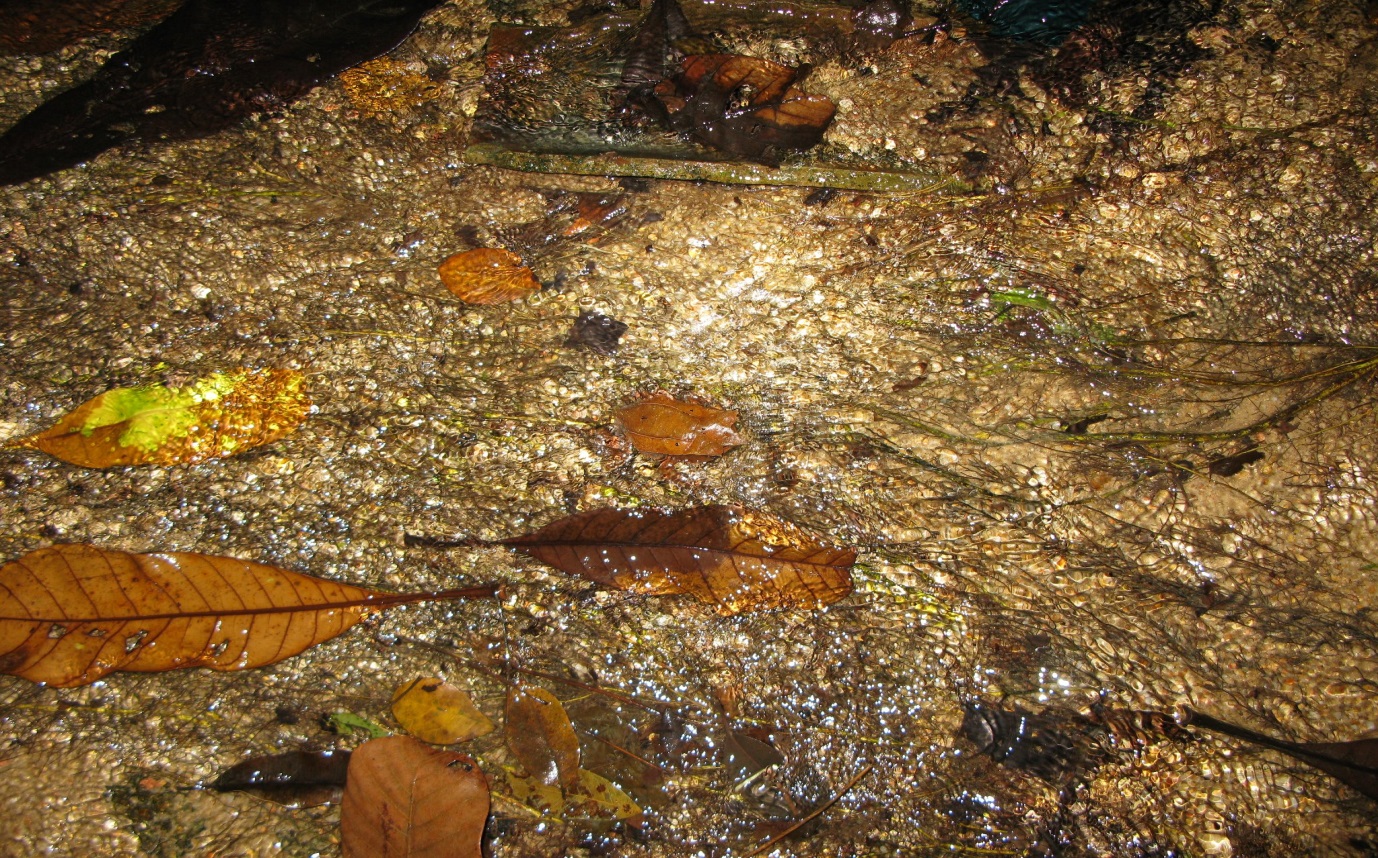
Spot the hidden Megophrys nasuta (Photo courtesy of Mary-Ruth Low)

Scroll to the bottom for the answer:)
PAGE NAVIGATION:
| MORPHOLOGY: | BIOLOGY | | | | DISTRIBUTION | CONSERVATION STATUS | DIAGNOSIS | TAXONOMY | USEFUL LINKS | REFERENCESMORPHOLOGY:
THE MARVEL OF CAMOUFLAGE
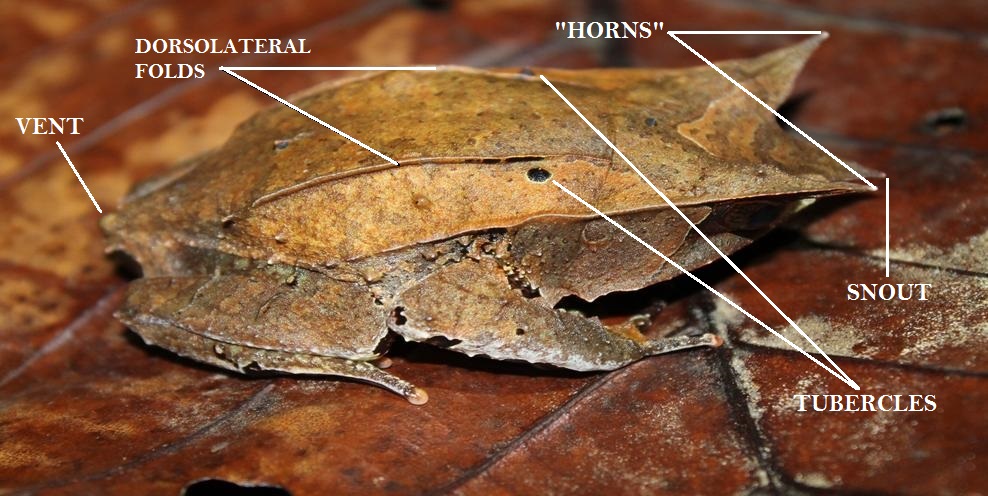 |
| Dorsal (back) view of adult Megophrys nasuta individual: the "horns", snout, vent, tubercles and dorsolateral folds are labelled. |
Megophrys nasuta is a sizeably large frog with adult males reaching 100-120 mm in snout-vent length (SVL: the length from snout to vent) and females capable of reaching a SVL of up to 160 mm (Malkmus et al., 2002). The species is characterized by the existence of prominent triangular projections on its upper eyelids and snout: these appendages create what looks like “horns” from which its common name, the ‘horned’ frog, is derived.
The head of the frog is relatively large and broad as compared to its body size with a hidden tympanum. The tympanum can be described as "...diagonally placed, rounded below, somewhat angular on upper edge, [and] separated from eye by a distance greater than greatest diameter of tympanum" (Taylor, 1962).
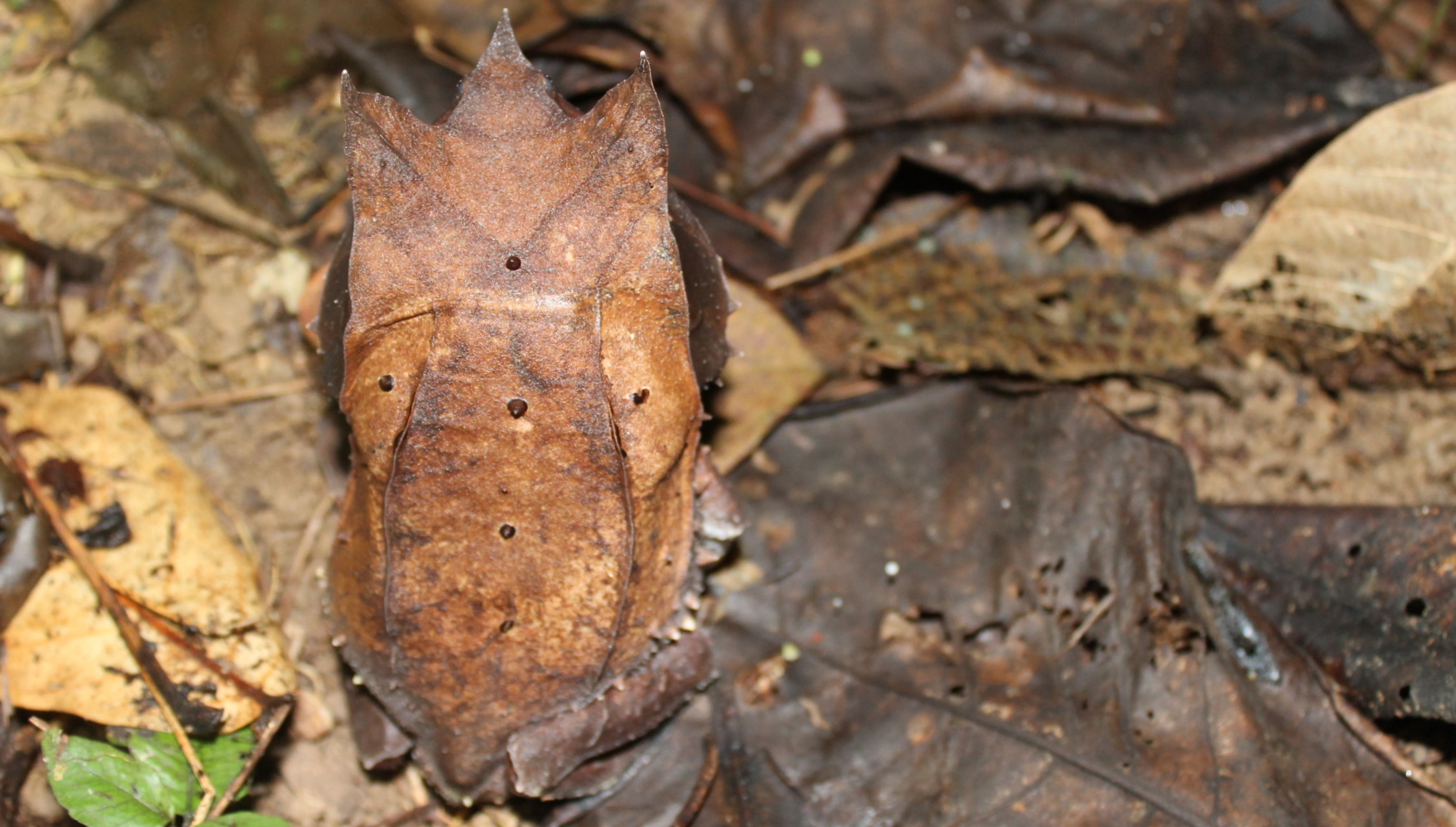
Dorsal view of M. nasuta adult. The frog’s excellent camouflage is largely due to both body shape and colour patterns that closely mimic that of dried leaves.

Two pairs of dorsolateral folds run parallel and longitudinally between its head and groin – the folds begin at the occiput (Inger, 1966). The dorsal (or back) surface of M. nasuta individuals range in colour from a light to dark brown and is marked by the presence of several raised tubercles. These tubercles serve to identify individual frogs as tubercle presence, shape, number and location on body surface vary from individual to individual. The colour of the frog allows it to blend in with the colour of leaf litter of the forest floor.
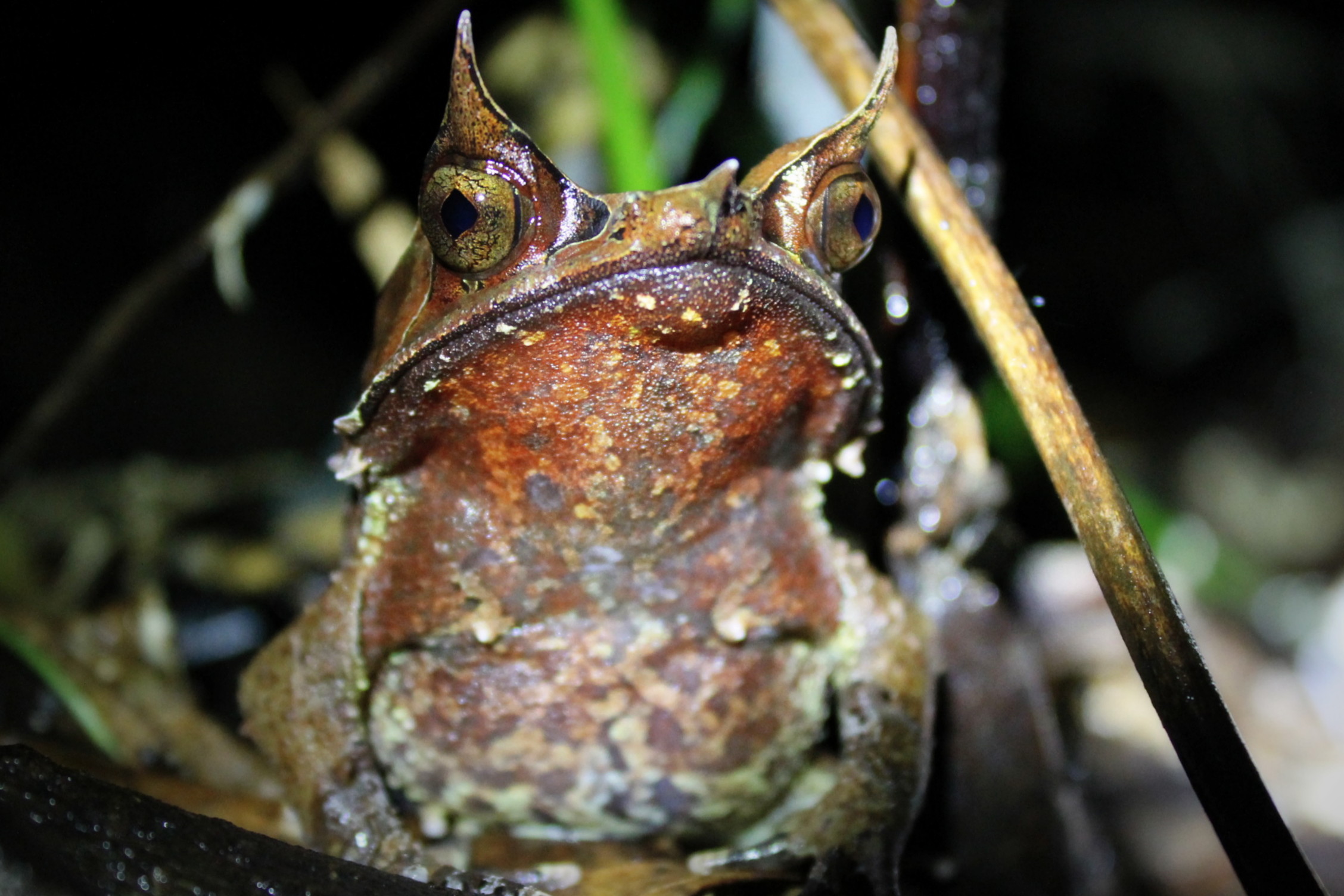 |
| Ventral view of the frog. Note the mottled appearance of the abdominal surface. |
The ventral (or abdominal) surface is a mottled brown colour that may become a cream-yellowish brown colour midway in some individuals.
The arms and legs are also marked by the mottled appearance – arms are moderate in size, and fingers are widened at the tips, and lack webbing between. Toes, however, show signs of webbing, while displaying similar widening at the tips as fingers (Inger, 1966).
All these morphological characteristics, especially that of head projections and its cryptic coloration, act as phytomimesis (which means the mimicry of plant structures or plants by animals) in the litterfall of the forest grounds (Inger, 1966; Wildenhues, 2012).
Despite its grumpy and disapproving demeanour, this species is actually shy in nature and will crouch down, motionless, when startled or disturbed. This is part of the frog's strategy to avoid detection and for greater camouflage among the leaf litter.
| Megophrys nasuta adopting a crouched position, enabling it to blend into the leaf litter (...perhaps a crouching frog thinks it is a hidden frog..) |
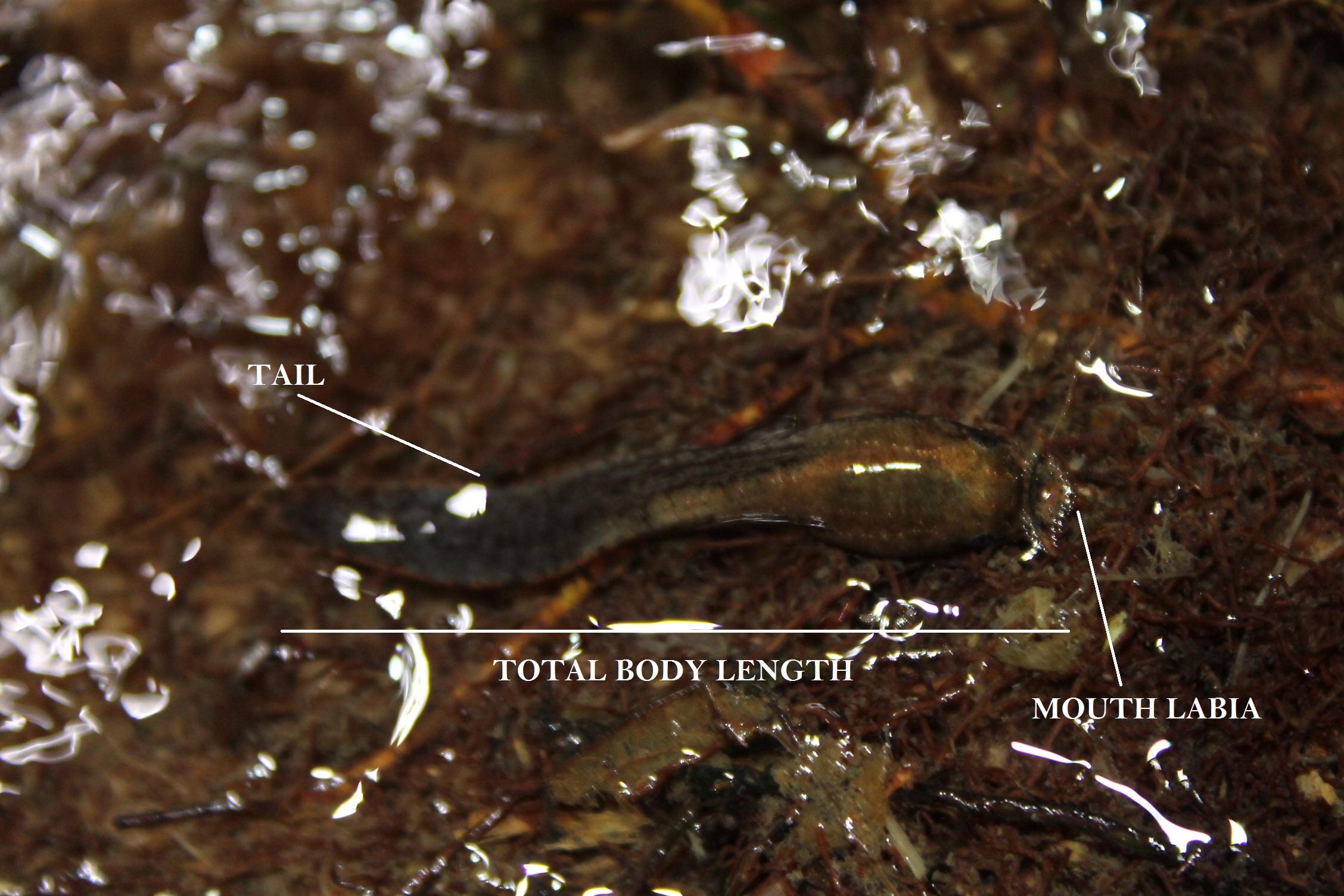 |
| Megophrys nasuta tadpole with a total body length of 35 mm |
Megophrys nasuta tadpoles are brown, their body shape distinctively elongate, and are capable of growing up to 42 mm during Gosner Stage 42 (Gosner, 1960; Inger, 1984). Tadpoles posses a distinctly shaped oral groove formed from the horizontal expansion of the lips, which results in a dorsally oriented funnel-mouth – this structure is unique to Megophryid species (Inger, 1984). Juvenile frogs are similar in colour to adults with noticeable protrusions at the eyelids and snout, although these are not fully formed.
For more details and pictures, please refer to the 'Biology' section below.
BIOLOGY
I. CALL
Megophrys nasuta individuals calling in Bukit Timah Nature Reserve.
Megophrys nasuta is known to inhabit mature rainforest or swamp forest, where its characteristic loud “honk” call can be heard especially during the early hours of dusk and just before rain: it is then that calling frequency increases, as opposed to almost solitary calls during the later hours of the night. This may be due to those periods being suitable breeding periods for the frog - it is perhaps useful to note here that most frogs usually call (period of greatest vocalization) in the later hours of dusk (Bickford et al., 2010).
II. LIFE CYCLE & REPRODUCTION
Megophrys nasuta exhibits inguinal amplexus: a type of amplexing position where the male clasps the female around her pelvic region. Males typically rest their feet on the female’s thighs (see picture). This posture is typically maintained for hours, (sometimes even for weeks), and pairs will usually not break away from the stance even when disturbed (Burger, 2000; Wildenhues et al., 2012).
Megophrys nasuta eggs are laid either adhered to surfaces in water or partially submerged in streams. Oviposition (that is, egg laying) is usually conducted beneath structures such as submerged logs or rocks. The large white eggs (of about 2 cm in diameter, including glutinous layer) are glutinous and laid attached to each other (Wildenhues, 2012). The larvae take approximately one week to hatch following egg deposition. The larvae are white and heavily dependent upon the yolk for sustenance and as a energy reservoir: following the early days of hatching, they remain motionless on the stream’s bottom.
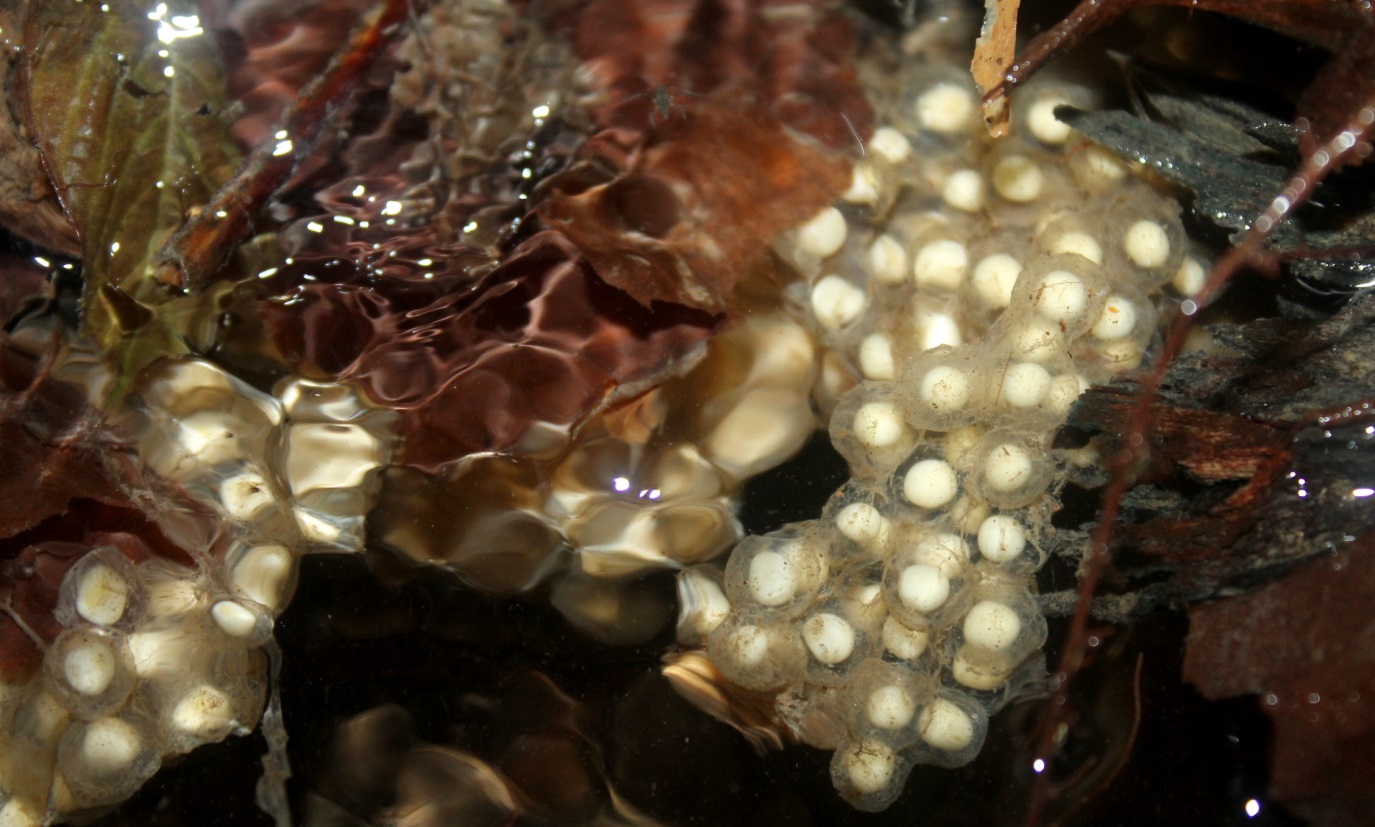 |
| Partial view of Megophrys nasuta egg clutch: eggs are usually laid partially submerged in water under structures such as dead wood or rocks. |
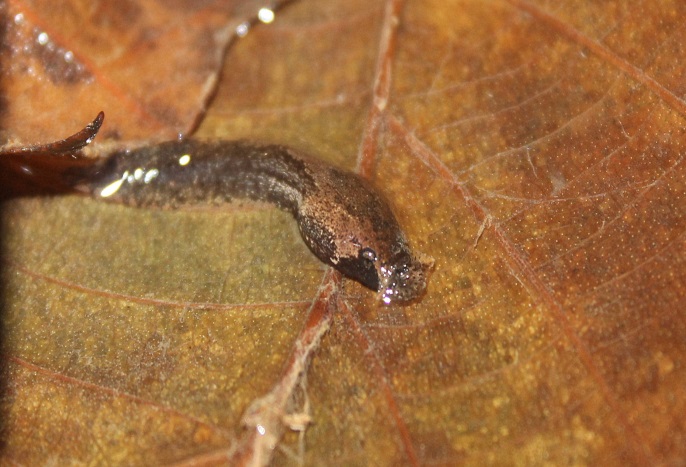 |
| Side view of Megophrys nasuta tadpole. The tunnel shaped mouth is clearly observed here. |
The larvae, when hatched, are a pale white in colour, and are attached to their yolk reservoir: a week later, they develop brownish pigment. Larvae begin to metamorphsose in about two and a half months, although this may be delayed to up to seven months, depending upon development temperature. Captive breeding of Megophrys nasuta has shown that lower temperature of development (ranging from about 19°C to 22°C) would result in a longer and slower development rate, while higher temperatures led to quicker development rates. However, larvae that developed quicker resulted in smaller metamorphs and juveniles as compared to that raised in lower temperatures (Wildenhues et al., 2012).
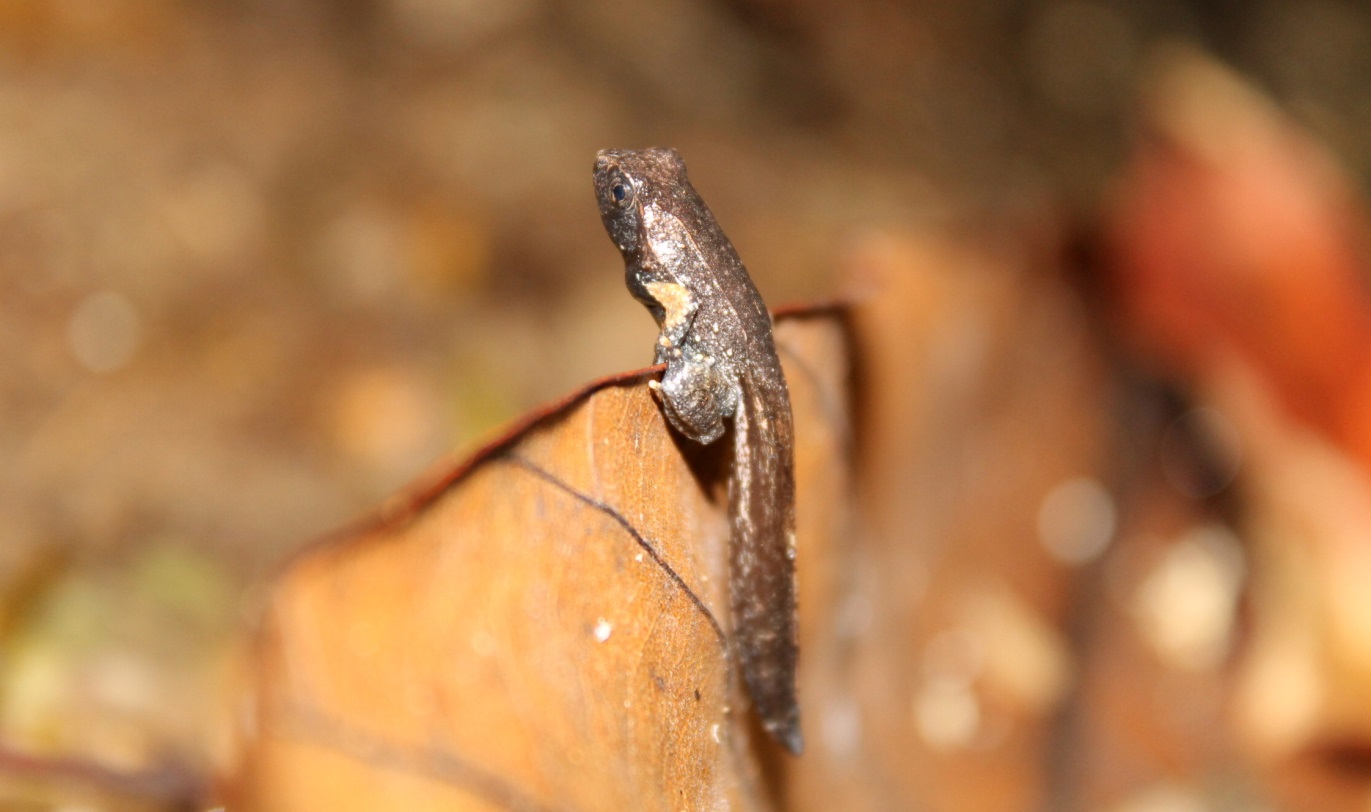 |
| Megophrys nasuta metamorph (with an SVL of 38 mm) at Gosner Stage 42 |
Larvae commence development from metamorphs (Gosner Stage* 45) into juvenile frogs (Gosner Stage 46) where their tail is completely resorbed from about three to seven months following egg deposition.
*Gosner Stages define different stages of the developing anuran young: from its two cell stage (Gosner Stage 1) to when it has completely resorbed its tail (Gosner Stage 47).
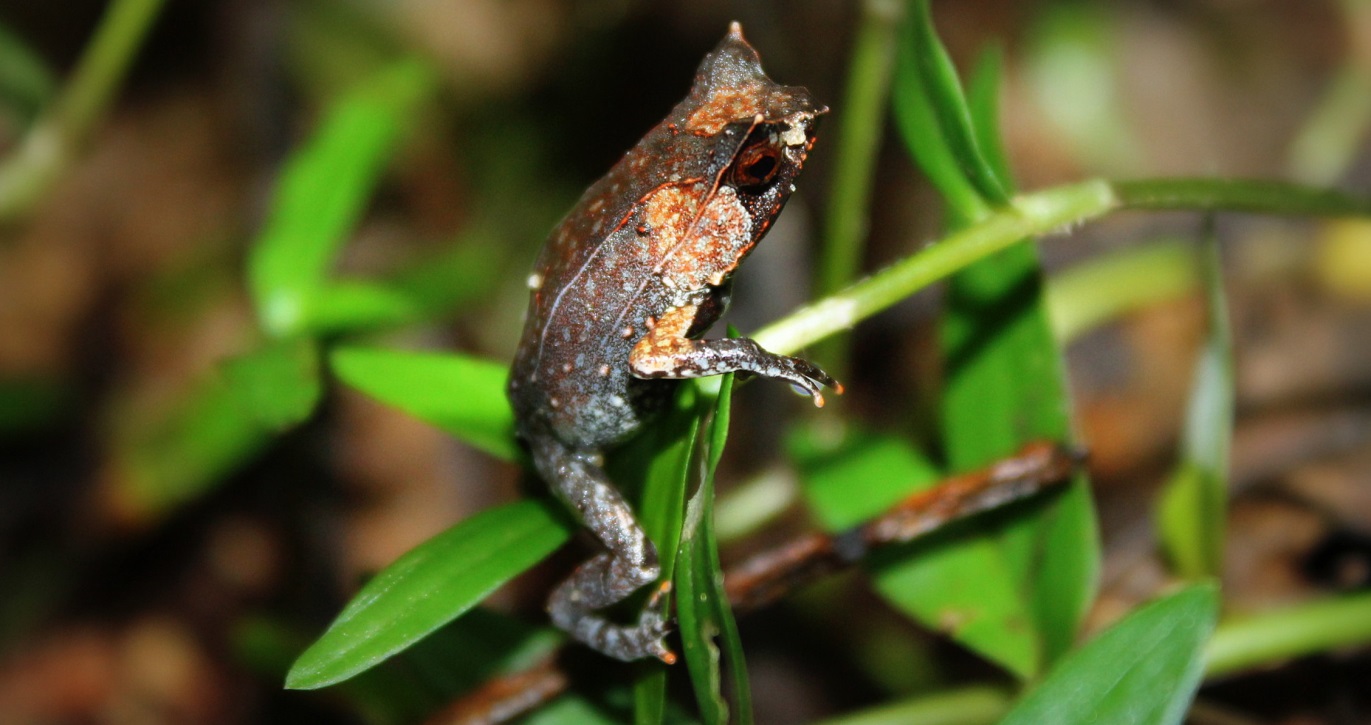 |
| Juvenile Megophrys nasuta. This individual had a snout-vent length of 18 mm and was found hiding along stream bank vegetation. |
III. DIET & FEEDING
Megophrys nasuta is known to be a voracious opportunistic predator. Adults are observed to feed on crickets, cockroaches, locusts, worms, slugs, and even snails, although this list is likely more diverse (Obst et al., 1984; Burger, 2000; Wildenhues et al., 2012). Its cryptic colouration and camouflage aid in its feeding strategy, allowing it to prey on smaller unsuspecting animals on the forest ground.Megophrys nasuta tadpoles are surface feeders.
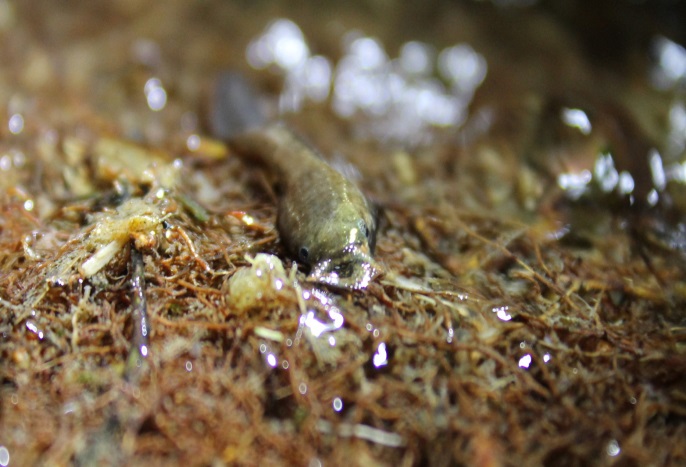 |
| Front view of M. nasuta tadpole. Note the funnel-shaped mouth. |
The large funnel mouth shape of M. nasuta tadpoles is a specialized structure for its feeding strategy. The funnel creates a suction that channels in water, which carries fine food particles such as algae, plankton and microbes. The tadpole then utilizes its internal oral ridges (fine folds in its oral cavity) to filter and select for appropriately sized and appropriate food in the water (Inger, 1954; Burger, 2000).
IV. HABITAT & ECOLOGY
Megophrys nasuta is known to primarily occur in mature rainforest - it is a forest specialist. The species inhabits lowland and submontane forests, and is usually found in the vicinity of clear forests stream: which serves as a necessary habitat for its tadpole and breeding grounds (Inger, 1954; Berry, 1975; Dring, 1979). In Singapore, it is found in the more pristine forested areas of Bukit Timah Nature Reserve, in addition to more mature swamp-forest in Central Catchment Nature Reserve (Teo & Rajathurai, 1997).Adult frogs are completely terrestrial in nature, although usually always found near streams. Tadpoles, however, spend their entire larval period in streams, and are often observed congregated on the sides of streams: they are known to favour the root mats of streamside vegetation, and areas of dead leaves accumulation, possibly as these are areas of greater plankton abundance (Inger, 1954; Burger, 2000).
DISTRIBUTION
I. GLOBAL
Globally, the native range of M. nasuta stretches from Yala, southern Thailand, throughout the Malay Peninsula, Singapore, Sumatra, Borneo, till the Natuna Islands.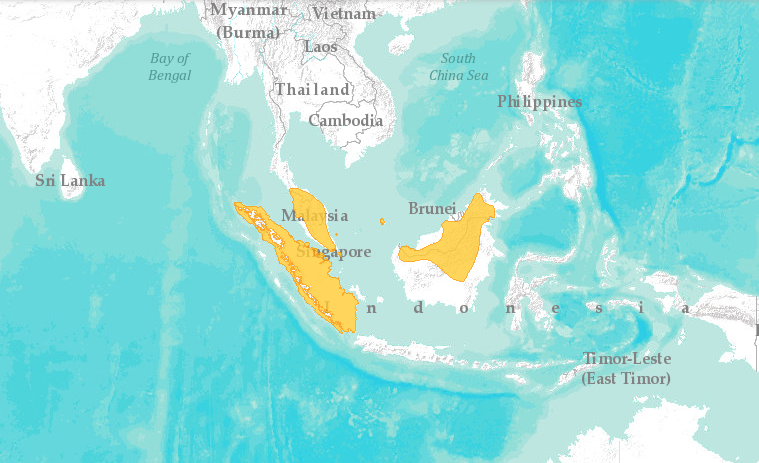 |
| Global distribution of Megophrys nasuta (map obtained from IUCN) |
II. SINGAPORE
In Singapore, M. nasuta is confined within the Central Catchment Nature Reserves (CCNR) and Bukit Timah Nature Reserve (BTNR). Due to sensitivity of this species’ location in Singapore, the exact sites within the reserves cannot be revealed.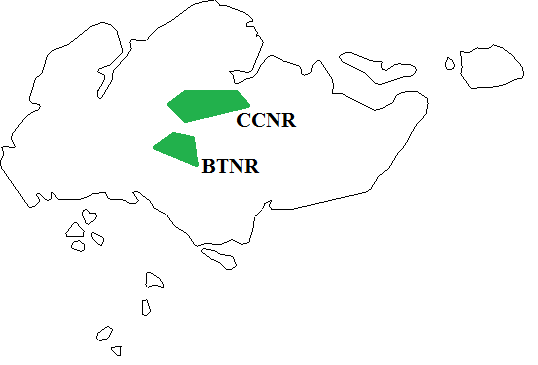 |
| Map of Singapore. Locations of Megophrys nasuta are found within the shaded areas. |
CONSERVATION STATUS
I. GLOBALLY
The International Union for Conservation of Nature (IUCN) lists M. nasuta as a taxon of ‘Least Concern’ due to its presumed wider distribution range, and population size (van Dijk et al., 2004). However, forest fragmentation coupled with habitat destruction and loss threatens population size—this is further compounded by harvesting for the pet trade (Wildenhues, 2012).WHY BOTHER ABOUT FROGS?
Frogs often serve as indicators of ecosystem health. Some frogs- such as forest specialists like Megophrys nasuta, are particularly sensitive (and susceptible!) to changes in the environment: such as rising temperature, a drop in precipitation, and even the presence of pollutants in the stream. In fact, because frogs (like many amphibians) are partly aquatic and partly terrestrial, this makes them even more vulnerable to environmental changes and decline.
II. SINGAPORE
A comprehensive survey of the amphibians in Singapore was carried out from 1993 to 1997 by Teo and Rajathurai of the Vertebrate Study Group of Singapore’s Nature Society. The survey, carried out over four years with a six year pre-survey period (1987 to 1993), listed 36 records of M. nasuta in Singapore, confined to Bukit Timah Nature Reserve and Catchment Nature Reserve. This was corroborated in part by M. nasuta records from ‘The Pangolin’, a quarterly bulletin of Singapore’s vertebrates published by the Malayan Nature Society Singapore (Lim, 1998c, 1989c, 1989d, 1990c, 1995). However, current knowledge regarding this species’ current status in Singapore is lacking or unpublished.The Singapore Red Data book currently records M. nasuta as Endangered [EN] (Davison et al., 2008). This category criterion is that "[T]here are fewer than 250 individuals and no evidence of decline or fragmentation" (Davison et al., 2008). However, a recent unpublished study on the conservation status of Megophrys nasuta in Singapore suggests that there was need to review this and possibly update the species’ local status to Critically Endangered [CR]. This category describes the possible current status of M. nasuta, considering that “[T]here are fewer than 50 mature individuals, OR if there are more than 50 mature individuals but less than 250, with some evidence of decline or fragmentation” (Davison et al., 2008). Although the number of mature individuals was not determined, the study recorded evidence of decline and absences from surveyed historical sites suggesting that the overall population size in Singapore is fewer than 250 individuals. However, these are but preliminary surveys, and more robust surveys must be conducted before revisions to status can occur. Regardless, management programmes tailored to address the various potential causes of decline should be developed and effectively monitored to prevent greater extirpation (localized extinctions) of M. nasuta in Singapore.
PAGE NAVIGATION:
| MORPHOLOGY: | BIOLOGY | | | | DISTRIBUTION | CONSERVATION STATUS | DIAGNOSIS | TAXONOMY | USEFUL LINKS | REFERENCESDIAGNOSIS
“Zij hebben in het algemeen de kenmerken der Kikvorschen; maar hun kop is veel grooter en plat; hun muil is buitengewoon wijd, en hunne bovenste oogleden zijn meer of min puntig verlengd. Men vindt hen in Zuid-Amerika en Achter-Indie.”“They generally have the characteristics of the frogs, but their head is much larger and flat; their mouth is extremely wide, and their upper eyelids are more or less pointed extended. One can find them in South America and Back Indies.”
-Hermann Schlegel, 1858
In Singapore, this species is easily distinguished from other frog species due to the prominence of its triangular projections of "horns" and snout.
However, M. nasuta does look similar to other Megophrys species (all of which are not found in Singapore). There are currently five recognized species under the Megophrys (Frost, 2011).
| Species |
Picture |
Location |
Brief Description |
||
| Megophrys nasuta (Malayan Horned Frog) |
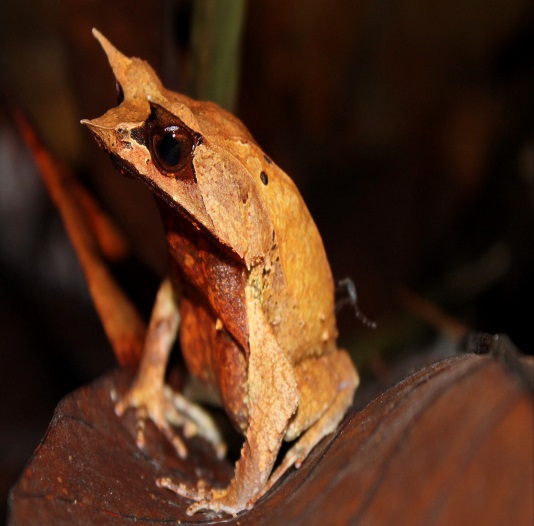 |
Endemic to Southeast Asia Region |
Description: Extended palpebral (eyelid) and snout projection with presence of tubercles on body and wide large head. Colour of dorsal surface ranges from light brown to dark brown. Colour of ventral surface is bottled brown to creamish brown in colour. Global Species Status: Least Concern |
||
| Megophrys kobayashii (Kobayashi’s Horned Frog) |
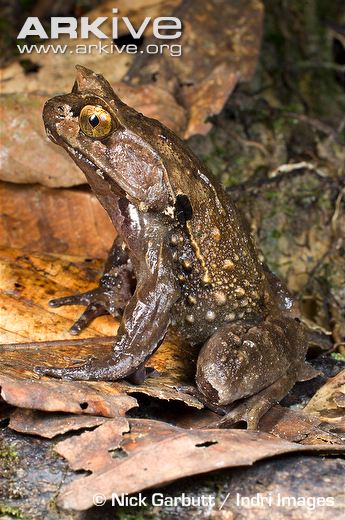 (Photo from ARKive, courtesy of Nick Garbutt/ Indri Images) |
Endemic to Sabah, including Mount Kinabalu |
Description: Palpebral slightly extended, with numerous warts on body surface. Lacks snout projection. Colour of dorsal surface is dark brown. Global Species Status: Near Threatened |
||
| Megophrys montana (Javan Horned Frog) |
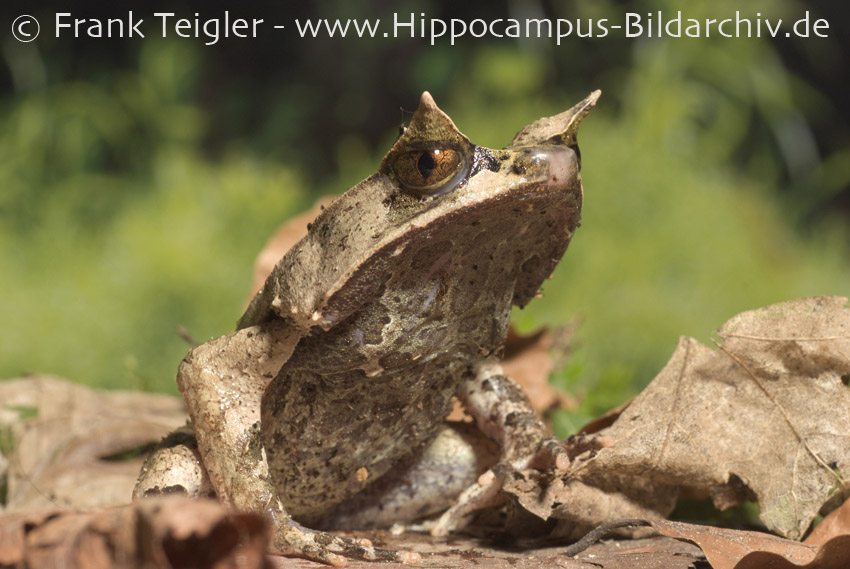 (Photo from CalPhoto database, courtesy of Frank Teigler, 2009) |
Endemic to Java, Indonesia |
Description: Elongated skin protrusion above each eyelid: extended palpebral projections with wide large head. Ventral surface is mottled light-dark brown in colour. Global Species Status: Least concern |
||
| Megophrys ligayae (Palawan Horned Frog) |
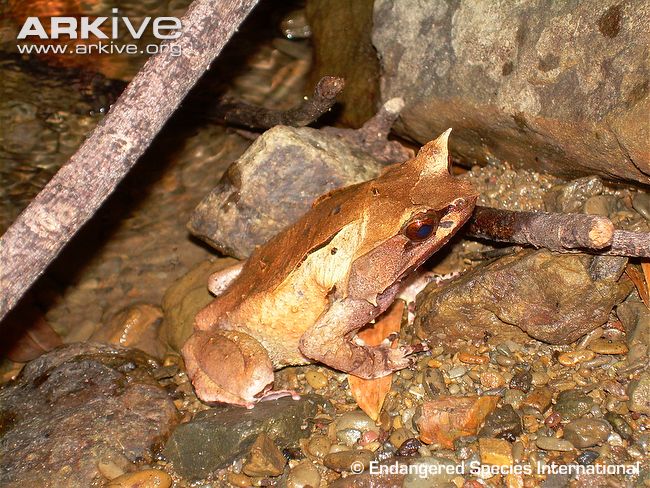 (Photo from ARKive, courtesy of Endangered Species International) |
Patchy distribution: known to occur in western Philippines |
Description: Extended palpebral. Has two pairs of dorsolateral ridges with a wide large head. Similar in morphology to M. nasuta, but is lacking the elongated pointed snout. Global Species Status: Endangered |
||
| Megophrys stejnegeri (Mindanao Horned Frog) |
(Photo from ARKive, courtesy of Philippine Eagle Foundation) |
Endemic to Mindanao |
Description: Brownish/greyish patterned bodies with scattered tubercles on skin surface. Tubercles greater in number as compared to that in M. nasuta. Body colour ranges from dark brown to greyish brown in colour. Has small skin protrusions above eyelid. Global Species Status: Vulnerable |
TAXONOMY
I. TAXONAVIGATION
- Amphibia
- Anura
- Megophryidae
- Megophrys
- Megophrys nasuta (Schlegel, 1858)
- Megophrys nasuta — Gee and Boring, 1929
- Megophrys nasuta (Schlegel, 1858)
- Megophrys
- Megophryidae
- Anura
II. ORIGINAL DESCRIPTION
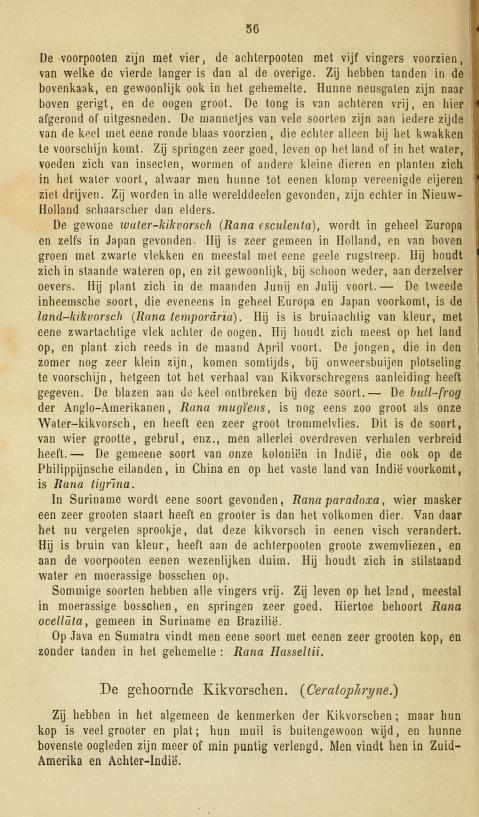
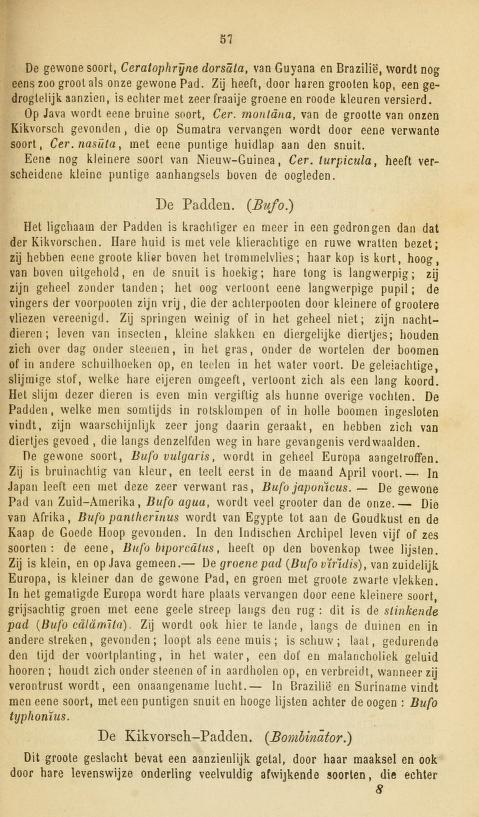
Original description of M. nasuta (page 56-57). Extracted from Schlegel, H. [1858]. Image courtesy of Biodiversity Heritage Library.
Schlegel orignally placed M. nasuta within the Ceratophryne genus - this was later revised several times and finally placed under Megophrys in 1929 by Gee and Boring (Gee & Boring, 1929).
The original description reads:
“Zij hebben in het algemeen de kenmerken der Kikvorschen; maar hun kop is veel grooter en plat; hun muil is buitengewoon wijd, en hunne bovenste oogleden zijn meer of min puntig verlengd. Men vindt hen in Zuid-Amerika en Achter-Indie.
De gewone soort, Ceratophryne dorsata, van Guyana en Brazilie, wordt nogeens zoo groot als onze gewone Pad. Zij heeft, door haren grooten kop, een ge-drogtelijk aanzien, is echter met zeer fraaije groene en roode kleuren versierd. Op Java wordt eene bruine soort, Cer. montana, van de grootte van onzen Kikvorsch gevonden, die op Sumatra vervangen wordt door eene verwante soort, Cer. nasuta, met eene puntige huidlap aan den snuit"
which translated:, reads
They generally have the characteristics of the frogs, but their head is much larger and flat; their mouth is extremely wide, and their upper eyelids are more or less pointed extended. One can find them in South America and Back Indies.
The normal species, Ceratophryne dorsata, [can be found] from Guyana and Brazil, will become just as big as a normal frog (sometime in the future but not now).She has, because of her big head, an ugly [appearance], however [it] is decorated with beautiful green and red colours.
On Java you find a brown species, Cer. montana which is of the same size of the other Amphibians, which is replaced on Sumatra by a related specie, Cer. nasuta, which has one pointed skin flap to the muzzle."
DID YOU KNOW?
How Amphib-uos!
Dr. Albert Gunther was a German zoologist and herpetologist who described more than 340 species. However, he mistakenly identified adult Megophrys montana males as Megophrys nasuta females (then referred to as Megalophrys montana and Megalophrys nasuta) - and only discovered his error when he was presented with specimens of larger size that were females, as compared to the smaller sized males that he dealt with (Gunther, 1873). Dr Gunther also mistakenly brought this information to Charles Darwin – who in his book ‘The Descent of Man, and Selection in Relation to Sex’, incorrectly wrote about the ‘differences’ between the "males" and "females" of Megalophrys montana, although these were in fact two different species.
III. TYPE SPECIMEN AND LOCALITY
Type Specimen: Two syntypes, RMNH 2143, deposited in the National Museum of Natural History, Leiden, The Netherlands (Miracle et al., 2007)
Type Locality: Batang Singalang, Sumatra, Indonesia
IV. PHYLOGENETICS
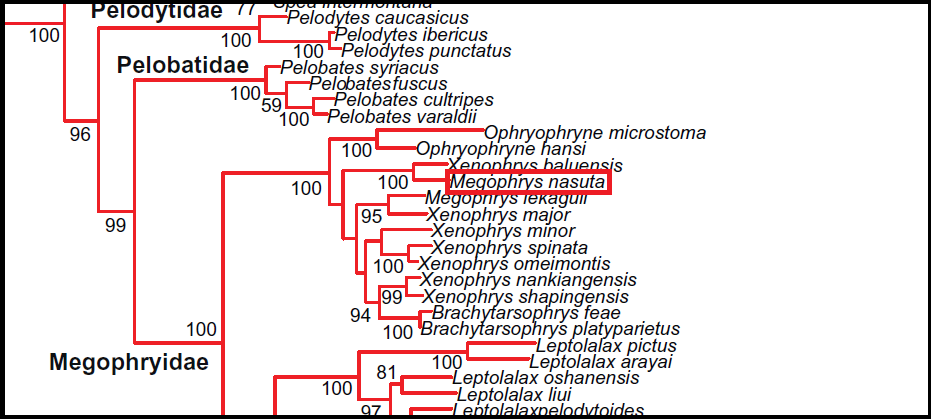
A recent study conducted by Pyron and Wiens in 2011 based on analysis of sequence data from 12 genes: three mitochondrial and nine nuclear reflects the position as Megophryidae as the sister taxon to Pelobatidae.
Megophryidae is accepted as monophyletic – this is based on analyses carried by Frost et al., using comparative anatomical character evidence of Haas (2003), with DNA sequences from mitochondrial transcription unit H1 and several nuclear genes: H3, rhodopsin, tyrosinase and the large ribosomal subunit 28S (Frost et al., 2006).
V. GENE SEQUENCES
| Barcode obtained from BOLD Systems from data deposited in GenBank, NCBI. (Clicking on the image will take you to the BOLDSystems Databse) |
COULD YOU FIND ME?
Mouse-over image to see enlarged image of the frog.
(Images adapted with permission from photo courtesy of Mary-Ruth Low)
*All pictures and other media are property of author unless otherwise stated.
USEFUL LINKS
For more information on Amphibians in Singapore:1. Nick Baker's page on Amphibians of South-east Asia
2. Wild Singapore's page on Amphibians in Singapore: A blog on Singapore's Wildlife.
REFERENCES
Berry, P. Y.(1975). Family Rhacophoridae. The Amphibian Fauna of Peninsular Malaysia. Tropical Press, Kuala Lumpur. pp. 90-109.
Bickford, D., Ng, T. H., Qie, L., Kudavidanage, E. P., and Bradshaw, C. J. (2010). Forest fragment and breeding habitat characteristics explain frog diversity and abundance in Singapore. Biotropica 42(1), 119-125.
Burger, R. M., (2000). Taxon Management Account: Malaysian Horned Frog, Megophyrs montana nasuta. In Frog Forum. Retrieved 10 November 2013, from http://www.frogforum. net
Davison, G. W., Ng, P. K., and Ho, H. C. (2008). The Singapore Red Data Book: Threatened Plants & Animals of Singapore. Nature Society (Singapore).
Dring, J. C. M. (1979). Amphibians and reptiles from northern Trengannu, Malaysia, with descriptions of two new geckos: Cnemaspis and Cyrtodactylus. Bull. Brit. Mus. Nat. Hist. (Zool.) 34(5): 181-241, I PI.17 Figs.
Frost, D. R., Grant, T., Faivovich, J., Bain, R. H., Haas, A., Haddad, C. F., De Sa, O. R., Channing, A., Wilkinson, M., Donnellan, S. C., Raxworthy, C. J., Campbell, J. A., Blotto, B. L., Moler, P., Drewes, R. C., Nussbaum, R. A., Lynch, J. D., Green. D. A. and Wheeler, W. C. (2006). The amphibian tree of life. Bulletin of the American Museum of natural History, 1-291.
Frost D. R. (2011). Amphibian Species of the World: An Online Reference. Version 5.5 (31 January 2011). [Online: Electronic Database. American Museum of Natural History, New York, New York]. Available: http://research.amnh.org/vz/herpetology/amphibia/ [Accessed 10 November 2013]
Gee, N. G. and Boring, A. M. (1929), Peking Nat. Hist. Bull., vol. 4, pt.2, pp. 20, 40
Gosner, K. L. (1960). A simplified table for staging anuran embryos and larvae with notes on identification. Herpetologica 16(3), 183-190.
Gunther, A. C. L. G. (1873) Contribution to our knowledge of Ceratophrys and Megalophrys. Annals and Magazine of Natural History, Series 4, 11: 417- 419. Available: http: // www.biodiversitylibrary.org/page/25121347 [Accessed 14 November 2013]
Haas, A. (2003). Phylogeny of frogs as inferred from primarily larval characters (Amphibia: Anura). Cladistics, 19(1), 23-89.
Inger R. F. (1954). Systematics and Zoogeography of Philippine Amphibia. Fieldiana Zoology 33, 183-531. Natural History Museum, Chicago, Illinois. p.531
Inger, R. F. (1966), The systematics and zoogeography of the amphibia of Borneo. Fieldiana (Zool.) 52, 1-402, 71 Figs.
Inger, R. F., Shaffer, H.B., Koshy, M., and Bakde, R. (1984). A report on a collection of amphibians and reptiles from the Ponmudi, Kerala, South India. Part 1. Journal of Bombay Natural History Society 81(2), 406-427.
Lim, K. K. P., (1989c). Recent reports: amphibians. The Pangolin, Malayan Nature Society Singapore Branch 2(3)
Lim, K. K. P., (1989d). Recent reports: amphibians. The Pangolin, Malayan Nature Society Singapore Branch 2(4)
Lim, K. K. P., (1990c). Recent reports: amphibians. The Pangolin, Malayan Nature Society Singapore Branch, 1(3)
Lim, K. K. P., (1995). Recent reports: amphibians. The Pangolin, Malayan Nature Society Singapore Branch
Lim, K. K. P. and Yang, C. M. (1991). ‘An annotated checklist of the amphibians of Singapore, with emphasis on material in the Zoological Reference Collection’, Raffles Bulletin of Zoology 39, 21 5-233.
Leong, T. M., and Chou, L. M. (1999). Larval diversity and development in the Singapore Anura (Amphibia). Raffles Bulletin of Zoology 47, 81-138.
Miracle, M. E. G., OSTENDE, L., & Arntzen, J. W. (2007). Type specimens of amphibians in the National Museum of Natural History, Leiden, The Netherlands. Zootaxa, 1482, 25-68.
Obst, F., K. Richter, and U. Jacob. (1984). Atlas of Reptiles and Amphibians for the terrarium. Neptune, City, NJ: T.F.H., Publishing, Inc..
Pyron, A. R., & Wiens, J. J. (2011). A large-scale phylogeny of Amphibia including over 2800 species, and a revised classification of extant frogs, salamanders, and caecilians. Molecular Phylogenetics and Evolution, 61(2), 543-583.
Taylor, E.H. 1962. The Amphibian Fauna of Thailand. University of Kansas Science Bulletin 43(8): 267-599.
Teo, R. C. H. and Rajathurai, S. (1997). Mammals, reptiles and amphibians in the Nature Reserves of Singapore – Diversity, abundance and distribution. In Chan, L and Corlett, R. T. (Eds), Biodiversity in the Nature Reserves of Singapore. (pp. 353 – 425). Singapore: National Parks Board.
van Dijk P. P., Iskandar D., and Inger R. (2004). Megophrys nasuta. In: IUCN 2011. IUCN Red List of Threatened Species. Version 2011.2. [Online]. Available: www.iucnredlist.org. [Accessed: 10 November 2013].
Wildenhues, M., Rauhaus, A., Bach, R., Karbe, D., van der Straeten, K., Hertwig, S. T., Ziegler, T. (2012): Husbandry, captive breeding, larval development and stages of the Malayan horned frog Megophrys nasuta (Schlegel, 1858) (Amphibia: Anura: Megophryidae). Amphibian and Reptile Conservation 5(3):15-28
HONK & HOLLER!
Anything to say about the Horned Frog?Thank you for reading this web-page! Should you have any queries or comments, spot an error in the information above or perhaps have more local (Singapore) information about this species, please feel free to drop me an email at prar.selv@gmail.com. :) Your comments are very much appreciated, and will help in adding to our knowledge of this species in Singapore.
